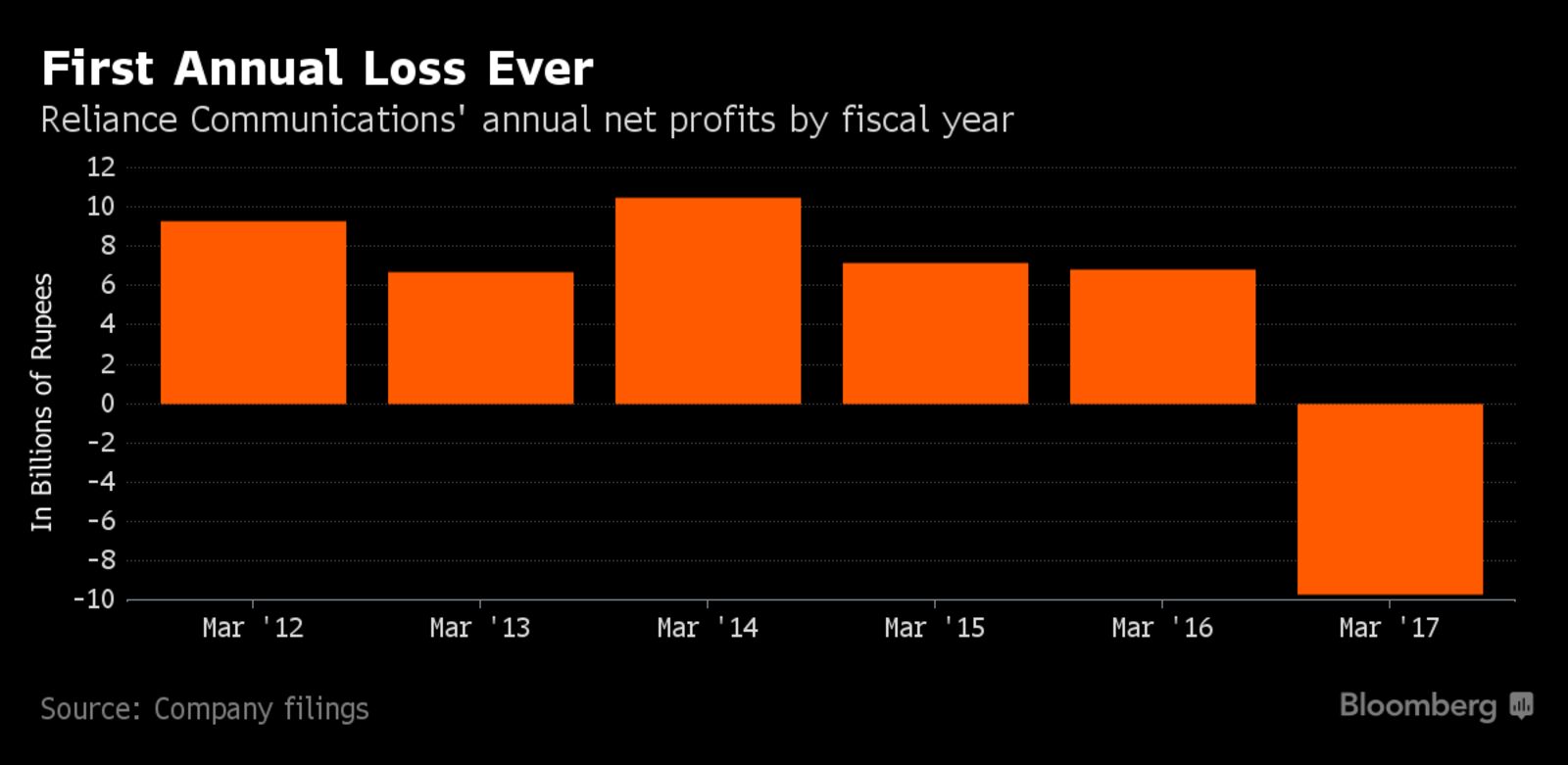-
Fitch Ratings, Lucror flag potential liquidity crunch
-
Size of company debt has become unmanageable: K M Visaria
Brutal competition and 457 billion rupees ($7 billion) of borrowings have finally caught up with billionaire Anil Ambani’s Reliance Communications Ltd.
The Indian wireless operator rattled investors with its first full-year net loss amid signs it’s struggling to repay debt. Its $300 million junk-rated note due in 2020 declined 5.5 cents on the dollar to 66 cents as of 12:23 p.m. in Hong Kong and the stock sank 4.4 percent to extend Monday’s 20 percent slump. Fitch Ratings and Lucror Analytics highlighted a potential liquidity crunch and people familiar with the matter said the company sought more time to repay some loans.
Top News: Bullfrog Gold Raises $816,000 Of Equity To Advance Its Nevada Gold Project
The company was in talks with its lenders to seek their approval for the sale of its tower business and an equal merger of its wireless business with rival Aircel Ltd., that would allow it to pare debt by 250 billion rupees, Gurdeep Singh, co-chief executive officer of Reliance Communications said on an investor call Monday. The company plans to refinance its debt in the interim period until Sept. 30 to facilitate the closing of the transactions, Singh said.
Here are four charts that show Reliance Communications’ financial challenges.

Reliance Communications had a full-year loss of 14 billion rupees. Subscribers have dwindled in the past five years as larger rivals such as Bharti Airtel Ltd. and Vodafone Plc slashed call rates and offered higher speed data. To repay debt, the company is selling its towers to Canadian asset manager Brookfield Infrastructure Group as well as merging the wireless business with Aircel Ltd.
Don’t Miss: Is This Tiny Gold Mining Company The Next Big Thing?
“The size of the RCOM debt has become unmanageable and both Brookfield and Aircel deals are getting delayed for a long time now,” Giriraj Daga, an investment manager at K M Visaria Family Trust in Mumbai. “Investors fear that a delay in loan repayments may lead to scrapping of the deals” and this may lead to financial stress at the company because it doesn’t have adequate refinancing resources, he said.

The carrier is likely to continue losing subscribers, Deepti Chaturvedi and Akshat Agarwal, analysts at CLSA Asia-Pacific Markets, said in a note Monday. CLSA estimates that only 66 million users are active, which is 20 percent lower than the company’s reported subscribers.
Reliance Communications’ cash generation and unrestricted cash of around $200 million would be insufficient to pay its short-term debt of around $600-$650 million, said Nitin Soni, director, Asia-Pacific corporate ratings at Fitch Ratings. However, liquidity would still be dependent on its ability to refinance maturing debt, Soni said.
Also see: Is this the end to banking as we know it?
The company also plans to sell its real estate assets in Delhi and Navi Mumbai, Singh said on the investor call. The company is getting the properties valued, he said.
The junk-rated company had 13.2 billion rupees of cash and cash equivalents as of March 31, less than a quarter of its short-term borrowings of 95 billion rupees, it said in its earnings report on May 27.
Reliance Communications has defaulted on loan servicing obligations and Indian banks have put the company’s loans into “special mention accounts,” which means interest payments are overdue, the Economic Times reported Monday, citing an unidentified bank official.
“Bank support would be the key thing investors are watching right now,” said Pavitra Sudhindran, credit analyst at Nomura Holdings Inc. “While we continue to view negatively the ongoing deterioration in operations, our base case is for banks to remain supportive but note that there could be potential headline risk, as we saw this morning.”
Reliance Communications’ shares are down 42 percent this year. In a sign of stress, the company’s leverage, measured by total debt to equity, rose to a record high of 1.6 times, up from one time in 2012, according to company filings.

Pinched by a 24 percent rise in financing costs in the latest quarter to March 31, the company’s ability to service its debt has fallen to the weakest since at least 2011. The company generated just enough cash to cover interest expenses, down from three times in March 2015.



